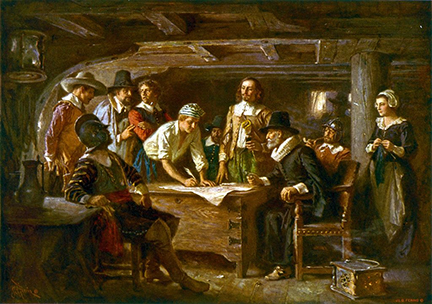 Today is Thanksgiving, the national day to stop and give
thanks. You might be gathering with your family to eat, watch a football game
or start your Christmas shopping. If you are like the family I grew up in, you
might even recreate the first Thanksgiving Day by dressing as Pilgrims and
Native Americans and sharing a meal together.
Today is Thanksgiving, the national day to stop and give
thanks. You might be gathering with your family to eat, watch a football game
or start your Christmas shopping. If you are like the family I grew up in, you
might even recreate the first Thanksgiving Day by dressing as Pilgrims and
Native Americans and sharing a meal together.
Why do we call those early residents of Plymouth Colony
the Pilgrims? The word pilgrim means a wanderer. It seems to me that they were
more like settlers – people who took a piece of wilderness and turned it into a
town or city, not a vagabond that drifted about, homeless and seeking after
something beyond themselves. It was never their intent to live a nomadic life.
The people who set out on the Mayflower to travel to North America were
intentionally trying to find a new place to set down their roots. In fact,
their aim was to sail to New York (then called northern Virginia.) They had a
charter from the Virginia Company, a British state-owned trading company that
financed the trip in exchange for a share in the profits from the trade that
would be established by the new colony. They were to create this colony on the
Hudson River. The problem was that after sailing for 65 days in very rough
seas, they were blown off course about 250 miles and ended up in Massachusetts.
That was when they discovered a very big problem. There were some men aboard
the Mayflower that argued that their charter had been to land the boat
somewhere else. Since they were not where they were supposed to be, they could
not be held accountable to the rules established before they set sail. They let
it be known that the community that was supposed to be formed was null and
void. It would be every man, woman and child fending on their own as soon as
they disembarked from the ship. Thus, they truly would be pilgrims wandering
about the wilderness. Mutiny was in the air.
What came of this was a solution, out of necessity, that
set the stage for the new nation that was to come. There were 102 passengers
aboard the Mayflower. Among them were 41 Christian separatists who had sailed
to the shores of Massachusetts – the ones we typically call Pilgrims. These
separatists came up with a new charter that defined the rules of a new
community. It has become known as the Mayflower Compact. It established four
broad laws that would govern the colony.
• They would be self-governed even
though they remained loyal to the King of England.
• They would establish and abide by laws
for the good of the colony.
• They would establish one society.
• They would live in accordance with
the Christian faith.
Before they got off the ship, 41 men signed the Mayflower
Compact to establish a new government for the colony. They elected leaders and
set out to create a new society. They were the first self-governed group of
settlers in what became the United States.
That still does not explain why we call them Pilgrims. The
truth is, they didn’t refer to themselves as Pilgrims. They called themselves "Old Comers.” Ten years after they
arrived, William Bradford, Plymouth Colony’s second governor, wrote about the
Christian separatists who made the voyage in 1620 across the Atlantic, calling
them "saints and pilgrims.” But the name really didn’t stick for another 200
years when Daniel Webster gave a speech about the brave Pilgrims who
established a self-governed colony on the shores of America. Webster was quick
to point out this democratic society because he was part of a new revolutionary
ideology that sparked the American colonies’ fight for independence. From that
point on, those Old Comers became known as Pilgrims – who wandered across the
Atlantic to establish a new society based on the rights of people to elect
their own leaders, own property, establish commerce, speak their minds,
establish laws to determine fairness and to worship as they saw fit.
When you sit down and eat your Thanksgiving meal, take a
moment to reflect on your own blessings. Among them should be a group of people
who established a set of rules that helped us become who we are today.
____________________
Painting: The Mayflower Compact, 1620 by Jean Leon
Gerome Ferris
The Pilgrims, History.com, December 2, 2009.
In a Word: How the Pilgrims Got Their Name, by Andy
Hollandbeck, Saturday Evening Post, November 26, 2020.